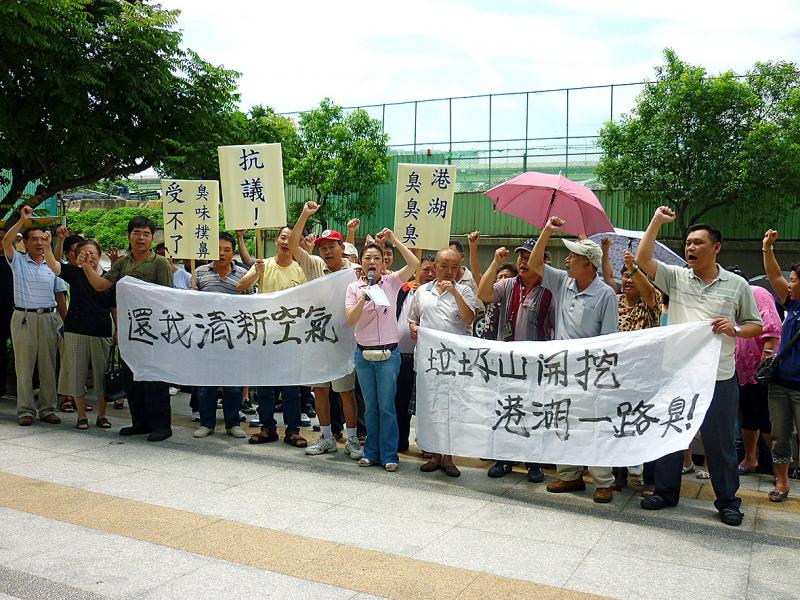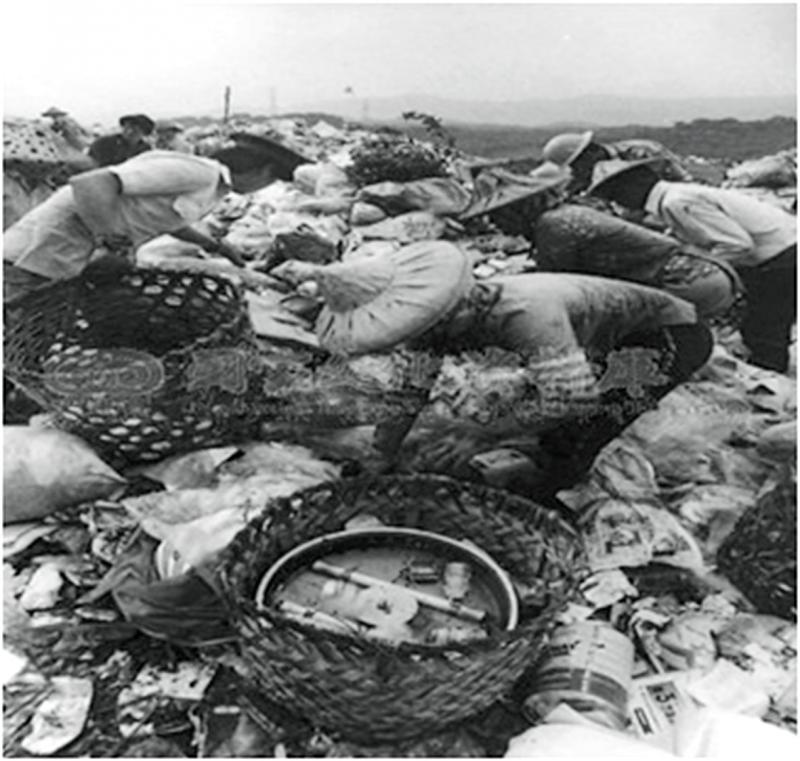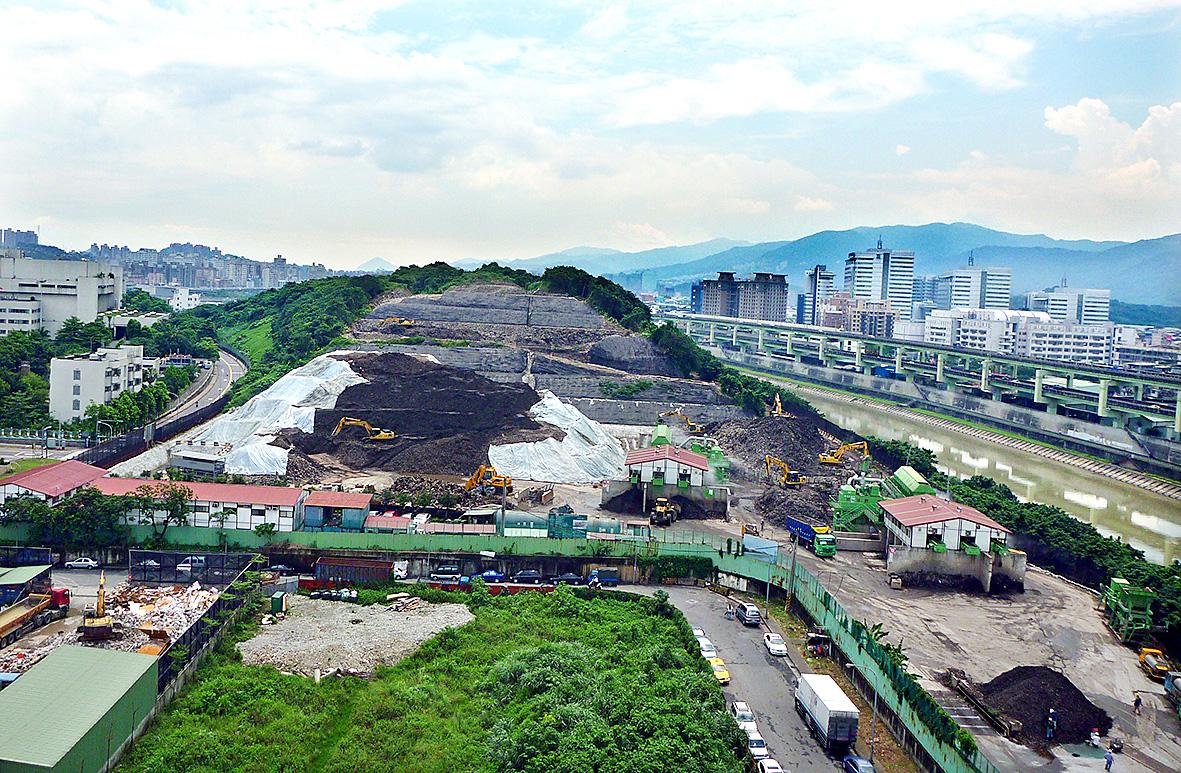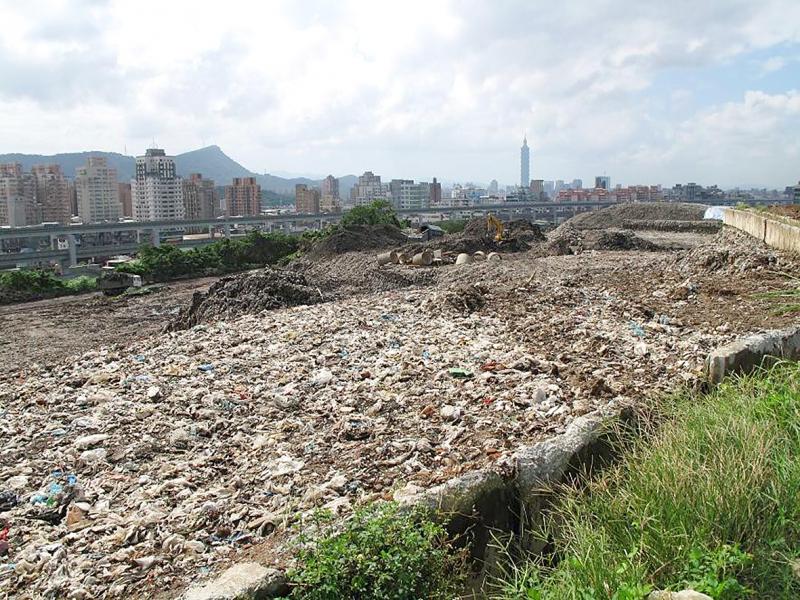July 11 to July 17
Ash and a putrid stench filled the air of eastern Taipei as the 53.86m high “Neihu Garbage Mountain” caught fire on July 13, 1984.
Firefighters in gas masks battled the flames for days, but the blaze only grew as the trash underneath soaked up the water and produced more bog gas as fuel.

Photo: Lin Hsiu-tzu, Taipei Times
Meanwhile, trucks continued to haul in load after load of the city’s waste.
“Where else can we put it?” an official told a Chinese Television System (華視) reporter. “It’s so hot out. If we don’t collect garbage for even one day, people won’t be able to bear it.”
The landfill was to cease operation a month earlier, but closure was delayed due to a snag in talks over the new site at Fudekeng (福德坑).

Photo courtesy of Taipei City Government
The government started dumping trash at the Neihu site in 1970, when the area was sparsely populated. It was a rudimentary disposal process, where a layer of dirt was put over the trash, and new trash was dumped on top of the dirt. There was no sewage system or leakage prevention mechanism, and the smell annoyed nearby residents and the runoff polluted the Keelung River.
Singer Lo Ta-yu (羅大佑) mocked the fire that year in his song Super Citizens (超級市民): “That year, we sat next to the Tamsui River, watching Taipei’s garbage drift past our eyes. Wafts of thick smoke billowed from afar, and the trash mountain was having a fireworks celebration. Let us cheer: Dear Taipei citizens, living in the colorful city where there’s too much garbage to burn. Let us stand united!”
The government finally began cleaning the mountain in 2006, and after eight years of work it was transformed into a public park.

Photo: CNA
FROM HOLE TO HILL
According to Documentation on the Removal of the Neihu Garbage Mountain (內湖垃圾山清除工程紀實報導), a book by the Taipei City Department of Environmental Protection, the area across the river from the mountain was home to many brick and tile factories that peaked during the 1940s and 1950s. The factories purchased earth from farmers across the river in Neihu, and an owner even built a bridge to transport the material. This soil mining eventually formed a large pit near Huzhou Village (葫州), and residents at some point began disposing their garbage there.
Taipei was searching for a new dumping ground when Neihu was incorporated into the city as a district in 1968. The original landfill was by the Songshan Airport, and was an eyesore for visitors. In 1970, the pit at Huzhou “conveniently” became the city’s official landfill, the book states.

Photo: Chen Wei-tzu, Taipei Times
The plan was to use the landfill for four years until the pit was filled up, but the city’s population exploded and the government was unable to find a new site. The trash the city produced jumped from 421,878 tonnes in 1970 to 755,565 tonnes in 1980, by which time the landfill had grown to 20m tall.
Former Environmental Protection Administration chief Ni Shih-piao (倪世標) says in the book that prior to the Neihu landfill, the city simply dumped its garbage on the shores of the river. The soil-and-garbage layered approach was adopted from Japan, but it wasn’t set up properly and the amount of garbage was simply too much for the system to handle.
TREASURE HUNTERS

Photo: CNA
Since there was no garbage separation then, all sorts of valuable items and artifacts could be found in the mountain. Hundreds of scavengers regularly visited it to make a living, and at night their headlamps could be seen flickering all over the hill.
Local borough warden Chen Ming-lin (陳明霖) recalls excitedly visiting as a child after the customs office dumped their confiscated items there, hauling home fresh fruit, packs of cigarettes and brand new VCR players.
Many of the scavengers were migrants to the city who fell on hard times. The book details the life of a woman named Ying-hua (櫻花), who began working at the garbage mountain at age 7 after her family moved to Taipei from Changhua. They lived near Songshan Airport and planned to scavenge at the dump there, but due to its closure, they rode their bikes to Neihu everyday.
“We separated what we found into neat piles in clearings amid the garbage,” she says. “There were unspoken rules, and people knew which items were already taken. At the end of the day, we went to look for buyers; if you scavenged all day you could make up to NT$3,000.”
They usually descended the mountain to buy lunch, but sometimes they ate fruit and other items they found on the mountain.
Occasionally people came looking for jewelry and other valuables that their family members had accidentally tossed out, and offered rewards to whoever found them — although they rarely succeeded. Ying-hua recalls that her most valuable find was a glass container full of gold rings.
When the mountain burned, the scavengers continued their work by using magnets attached to poles to collect metal cans.
Ying-hua spent 14 years on the mountain and married a city trash collector, who wooed her by saving valuable items for her. After her child was born, she continued to scavenge with the baby tied to her back. She was operating a car wash nearby when the book was published in 2014, and she wished there was another trash mountain in Taipei for her to scavenge in — although she knew it would be impossible due to recycling.
CLEANING UP
The mountain caught fire several times in 1983, leading to severe air pollution. It also partially collapsed, endangering the lives of those working there. The 1984 fire lasted nearly two weeks, drawing criticism from nearby residents and politicians.
Garbage mountain was finally closed the following year with the opening of Fudekeng. The city also began constructing incinerators. At the time of its closure, the mountain was 53m tall, 1,060m long and 350m wide. It had completely swallowed up the original bridge built by the factory owners.
Work was done in the ensuing years to reduce leakage and pollution, and the mountain sat silently for a decade while its surroundings changed with the straightening of the Keelung river and the opening of Huandong Boulevard (環東大道).
When Typhoon Herb hit the city in the summer of 1996, authorities realized that the record-breaking floods in the area were caused in part by trash mountain occupying parts of the river’s watershed zones. But where would they move the mountain?
Several more typhoons and serious floods later, and the city could no longer ignore the problem while locals launched a protest campaign. Taipei’s waste burden was reduced significantly with the introduction of the trash bag system, leaving more resources for the project. In 2001, the Ministry of Economic Affairs’ Water Resources Agency directed the city to remove the mountain as soon as possible.
Construction began on Dec. 23, 2006, taking eight years and much grief to complete. Many curious artifacts were unearthed, from stone mills and bronze decorations to weapons such as swords and grenades. The buried bridge was also unearthed, and its concrete pier was preserved. In 2015, it was opened as a park.
Taiwan in Time, a column about Taiwan’s history that is published every Sunday, spotlights important or interesting events around the nation that either have anniversaries this week or are tied to current events.

Many people noticed the flood of pro-China propaganda across a number of venues in recent weeks that looks like a coordinated assault on US Taiwan policy. It does look like an effort intended to influence the US before the meeting between US President Donald Trump and Chinese dictator Xi Jinping (習近平) over the weekend. Jennifer Kavanagh’s piece in the New York Times in September appears to be the opening strike of the current campaign. She followed up last week in the Lowy Interpreter, blaming the US for causing the PRC to escalate in the Philippines and Taiwan, saying that as

US President Donald Trump may have hoped for an impromptu talk with his old friend Kim Jong-un during a recent trip to Asia, but analysts say the increasingly emboldened North Korean despot had few good reasons to join the photo-op. Trump sent repeated overtures to Kim during his barnstorming tour of Asia, saying he was “100 percent” open to a meeting and even bucking decades of US policy by conceding that North Korea was “sort of a nuclear power.” But Pyongyang kept mum on the invitation, instead firing off missiles and sending its foreign minister to Russia and Belarus, with whom it

The Chinese Communist Party (CCP) has a dystopian, radical and dangerous conception of itself. Few are aware of this very fundamental difference between how they view power and how the rest of the world does. Even those of us who have lived in China sometimes fall back into the trap of viewing it through the lens of the power relationships common throughout the rest of the world, instead of understanding the CCP as it conceives of itself. Broadly speaking, the concepts of the people, race, culture, civilization, nation, government and religion are separate, though often overlapping and intertwined. A government

Nov. 3 to Nov. 9 In 1925, 18-year-old Huang Chin-chuan (黃金川) penned the following words: “When will the day of women’s equal rights arrive, so that my talents won’t drift away in the eastern stream?” These were the closing lines to her poem “Female Student” (女學生), which expressed her unwillingness to be confined to traditional female roles and her desire to study and explore the world. Born to a wealthy family on Nov. 5, 1907, Huang was able to study in Japan — a rare privilege for women in her time — and even made a name for herself in the